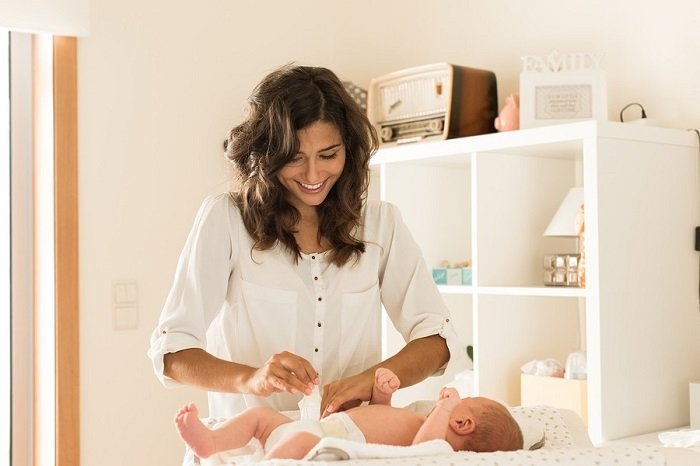The majority of the newborns and children, up to three years old, get diaper rashes, despite their mothers’ efforts of creating a high hygienic environment for their babies.
The good news is you don’t have to freak out since this is a common situation for almost any mom and there is a multitude of solutions developed to fight against it.
Understanding the causal factors, along with the overall development mechanism of the rash, will lead you in choosing the best product for severe diaper rash. In order to keep the rash away, you will have to develop an entire ritual, involving using top rated products.
Bad Diaper Rash: Causes, Diagnosis, and Treatment
The skin of your little one is fragile, just like its immune system. Introducing him to all sorts of chemicals, perfumes or baby cosmetics can cause rashes and dry its skin.
Newborns have wrinkled skin, covered, to a smaller or larger extent, by a protective layer called vernix caseosa, that gradually disappears during the first week.
It is predominantly made from fatty acids and has the role of protecting the delicate skin of the baby, both in the intrauterine life and once the baby is born. Therefore, it is not advisable to remove it too quickly by vigorous washing, as this is the first factor fighting against diaper rash formation.
What is a diaper rash? It is an inflammation of the skin, appearing in the diaper area. As symptoms, the baby skin may look inflamed and feel warm when you touch it.
This rash can manifest under an easy form, with just a few red spots in a small area, or it can take a severe form, with a rash extending to the belly and the baby’s thighs.
What causes diaper rash? Several factors are believed to create a pleasant environment for the appearance of a diaper rash:
- Humidity.
- Ammonia from poop and urine.
- Feeding, the little one, new foods.
- Irritation caused by using a new product.
- Bacterial or fungal infections.
- Sensitive skin.
- Using antibiotics.
However, you can heal and prevent diaper rash following some efficient habitual steps along with using top-rated care products.
5 The Best Product for Severe Diaper Rash
1. Baby Dove Tip to Toe Wash, Rich Moisture
It is important to limit the use of cosmetic products, within the first period (months) of your baby’s life. The bath can be made with a bath sponge and possibly a small amount of baby-cleaner, pH neutral, “head to toe” type.
Solid soaps or bath foam should be avoided and during the bath, you should predominantly insist on the baby’s inguinal, axillary and cervical areas.
2. Seventh Generation Thick & Strong Free and Clear Baby Wipes
[amazon_link asins=’B009D028GC’ template=’photo-only’ store=’purelifegal-20′ marketplace=’US’ link_id=’6ff69c47-9538-11e8-a1e2-19b48b7e684a’]
When you are dealing with severe diaper rashes, washing might become painful, for your newborn, due to burning sensations. Its skin is damaged and extremely sensitive; therefore, warm water might trigger painful sensations when touching the rash affected areas.
It is advisable to use alcohol-free cleansing wet napkins for babies and forget about water and soap for cleaning, at least for a while.
After using the napkins, leave the affected area uncovered, as long as possible, to help dry the damaged skin. Also, apply a cream designed to heal severe diaper rashes.
3. Boudreaux’s Butt Paste Diaper Rash Ointment
After each change of diaper, it is advisable to use a diaper rash treatment. Do not use baby powder because its dust is harmful to babies’ lungs.
Instead, choose some cream rich in zinc and paraben-free. For a severe diaper rash choose a treatment with a higher concentration of zinc, since this mineral has anti-inflammatory properties and will rush the wound healing process.
Also, look for mineral oils, in the composition of the cream, you will use, as they hydrate the damaged skin of your baby, reducing the pain and burning sensations. After the rash heals, make sure you will use a cream, with a smaller concentration of zinc, to prevent the rash from coming back.
4. Motherlove Diaper Balm for Persistent Diaper Rash
[amazon_link asins=’B000GLK6K2′ template=’photo-only’ store=’purelifegal-20′ marketplace=’US’ link_id=’a01507df-9538-11e8-9656-c3f5d0160ac9′]
Another reliable bad diaper rash treatment can be found in the organic creams or balms. The olive oil based balms are the most recommended since the fats in olive oil are similar to fats in human skin.
So they will be the least likely to amplify the irritation of the baby’s skin. Also, the olive oil has high moisturizing properties, leaving the skin soft.
The only disadvantage would be its smell; therefore, to avoid making your baby smell like a salad, you can opt for balms incorporating ingredients like beeswax, herbs or fruit to give it a more pleasant odor.
5. Pampers Swaddlers Disposable Diapers
[amazon_link asins=’B0721JS9ZW’ template=’photo-only’ store=’purelifegal-20′ marketplace=’US’ link_id=’b53b272a-9538-11e8-a1ba-6b44c7719f36′]
The main cause for bad diaper rashes is related to wearing diapers that do not allow the skin to breathe. The ammonia, contained in the urine and within the baby’s stool, irritates the sensitive skin and causes discomfort for both of you.
The best treatment, to help you get rid of diaper rash, is to keep the baby’s skin as clean and dry as possible.
You may opt for nappies or disposable diapers, but most of the moms choose disposable diapers as they ask for a minimal maintenance effort.
Regardless of the type of diaper used, it is recommended to change the baby as soon as possible after the diaper gets dirty, to keep the baby’s skin dry and clean.
Final Thoughts
The dreadful diaper rash should give up, after a few days, if you follow these tips. If the diaper rash persists, it is advisable to consult a pediatrician for more detailed recommendations.
Beware of possible allergies, to components in baby cosmetic products, that may manifest as diaper rashes! Remember that by using antibiotics you kill bacteria – good or bad.
Without the presence of good bacteria, there is a high risk of fungal infections. This can happen when the baby is given antibiotics or when the mother who is breastfeeding is undergoing antibiotic treatment.


